Menus
- Differences between the versions
- Differences in equipment
- Engine configurations and top performance
- Street Triple R with more torque at 8,000 rpm
- Top model strikes back
- Standard tires and chassis
- Conclusion
- Test in the handling course
- MOTORCYCLE test result
- The three Triumph Street Triple sisters in direct price comparison
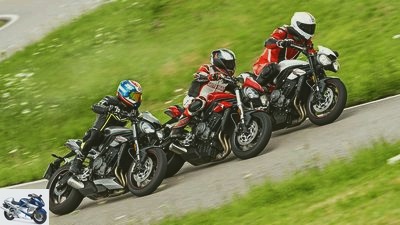
Rossen Gargolov
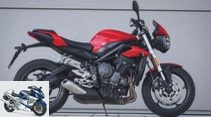
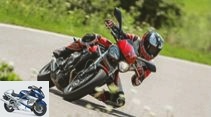
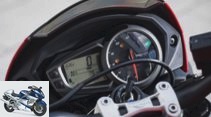

32 photos
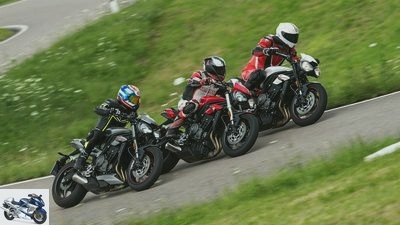
r-photography.info
1/32
Triumph Street Triple RS: power 123 hp, weight 190 kg, price 11600 euros
Triumph Street Triple S: power 113 hp, weight 192 kg, price 8900 euros
Triumph Street Triple R: output 118 hp, weight 190 kg, price 10,200 euros
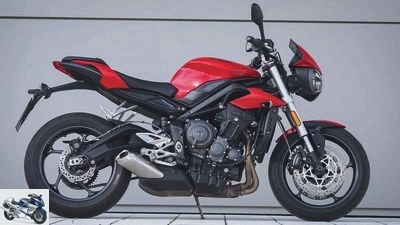
r-photography.info
2/32
At the rear, the Street Triple S is slightly lower than the other two models, and the seat height is 25 millimeters lower.
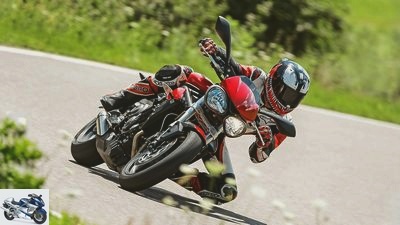
r-photography.info
3/32
Triumph Street Triple S: With a full tank of 192 kilograms, the cheapest Streety quickly sweeps around corners.
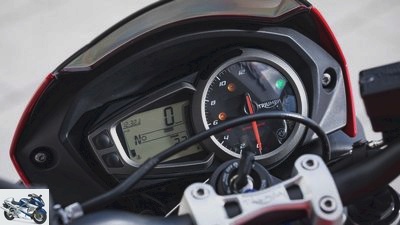
r-photography.info
4/32
The Street Triple S is characterized by a large rev counter and an LC display, and it is easy to read.

r-photography.info
5/32
The slightly too soft shock absorber can only be adjusted in the preload, level 6 as a recommendation.
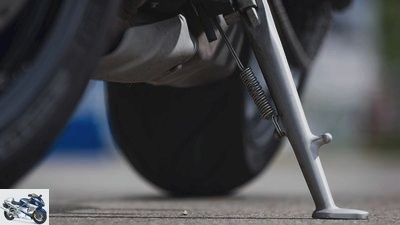
r-photography.info
6/32
A small detail that only the S has: the delicate extension arm on the side stand for greater ease of use.
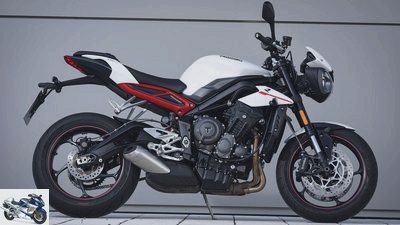
r-photography.info
7/32
With the Street Triple R, a fully adjustable chassis, a radial brake pump and similar calipers have found their way into the series.
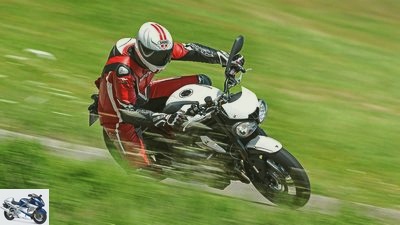
r-photography.info
8/32
Triumph Street Triple R: It doesn’t have the highest performance, but the beariest start. A pleasure on the country road.
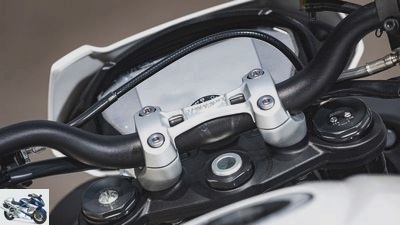
r-photography.info
9/32
TFT display and adjustable fork, left bar for preload, right bar for rebound and compression damping.
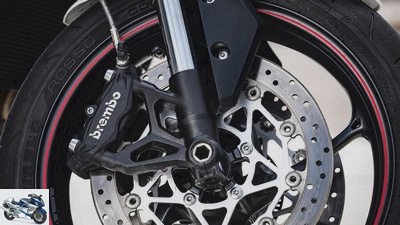
r-photography.info
10/32
That slows you down! Brembo’s M4.32 pliers put a lot of pressure on the 310 washers on the front wheel.
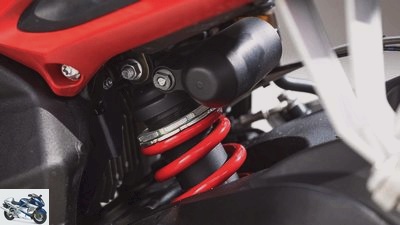
r-photography.info
11/32
As with the S, the shock absorber is also from Showa, but can be adjusted in many ways and offers more reserves.
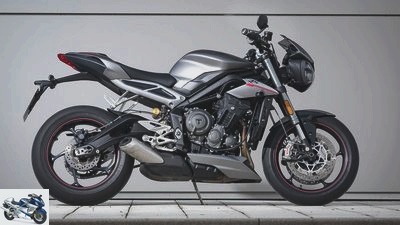
r-photography.info
12/32
Brembo’s M50 saddles work on the fork. Another immediately visible extra of the RS: the front spoiler painted in the vehicle color.
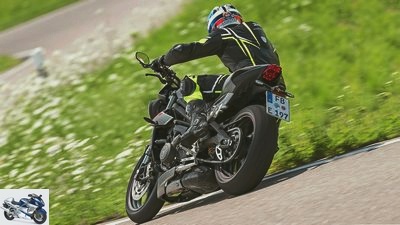
r-photography.info
13/32
Triumph Street Triple RS: As precise as the cut of a scalpel, the RS sweeps the narrowest line around the corner.
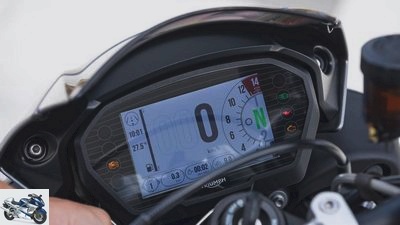
r-photography.info
14/32
As with the R, there is a tilt-adjustable TFT display that is very easy to read.

r-photography.info
15/32
Be beautiful without a passenger: the cover is reserved for the RS, the pillion seat is included.
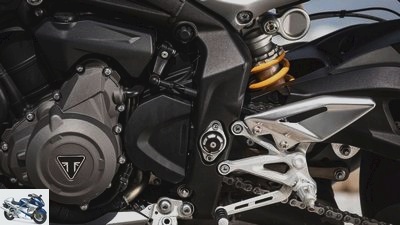
r-photography.info
16/32
In the background the Ohlins STX40 shock absorber, in the foreground the Quickshifter for quick upshifts.
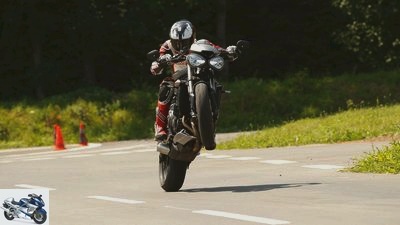
bilski-fotografie.de
17/32
At high speeds, the RS is moving forward. This protects the front wheel profile.
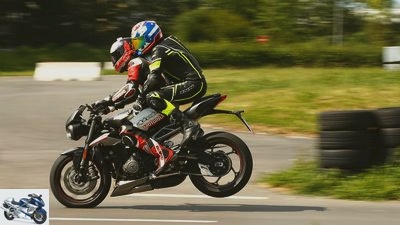
bilski-fotografie.de
18/32
For the picture again the RS in ABS-Track-Mode. The rear wheel stands and takes off. In road mode, however, the RS is flawless.

bilski-fotografie.de
19/32
For drift artists: In the track mode of the RS, the rear wheel can lock up, black lines adorn the entrance to the bend.

r-photography.info
20/32
Triumph Street Triple series in comparison.
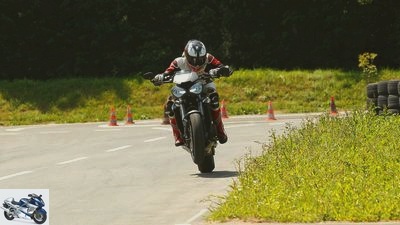
bilski-fotografie.de
21/32
Triumph Street Triple R..
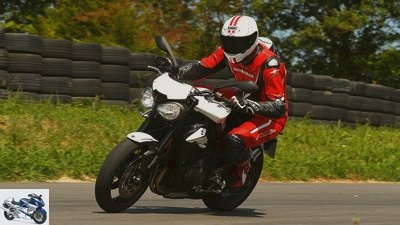
bilski-fotografie.de
22/32
Triumph Street Triple R..
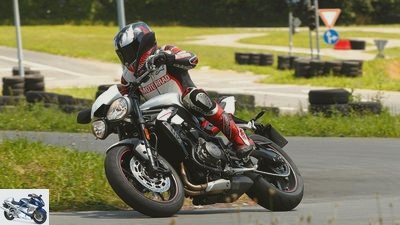
bilski-fotografie.de
23/32
Triumph Street Triple R..
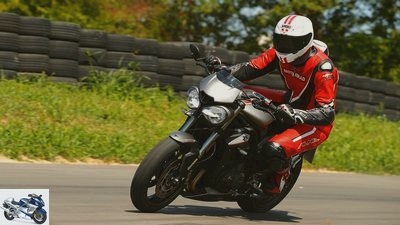
bilski-fotografie.de
24/32
Triumph Street Triple RS.
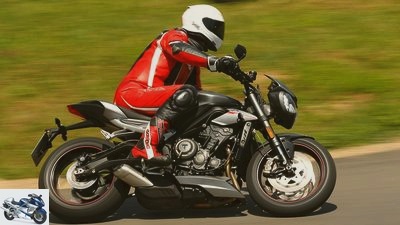
bilski-fotografie.de
25/32
Triumph Street Triple RS.

bilski-fotografie.de
26/32
Triumph Street Triple RS.

bilski-fotografie.de
27/32
Triumph Street Triple S.
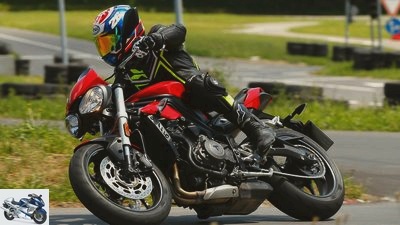
bilski-fotografie.de
28/32
Triumph Street Triple S.
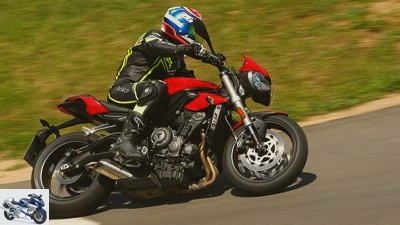
bilski-fotografie.de
29/32
Triumph Street Triple S.
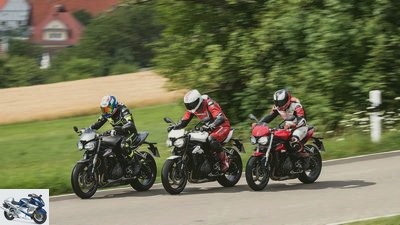
r-photography.info
30/32
Triumph Street Triple series in comparison.

r-photography.info
31/32
Triumph Street Triple series in comparison.

r-photography.info
32/32
Triumph Street Triple series in comparison.
Triumph Street Triple S, R and RS put to the test
Differences between the versions
The Triumph Street Triple program includes three models with the S, R and RS versions. The three-cylinder, which has grown to 765 cm³, works in all of them – with different performances. There are also big differences in price. Our test shows how this is noticeable.
Powerful engine, sporty chassis: With these ingredients the Triumph convinced S.kick triple away from the start. It should get even better with the 2017 vintage. Finally, the English three-cylinder got an increase in displacement – what was once 675 cc has now become 765 ccm³. In all three versions of the Triumph Street Triple series.
Buy complete article
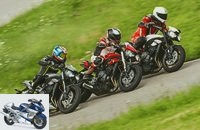
Triumph Street Triple S, R and RS put to the test
Differences between the versions
Seating positions on the Triumph Street Triple
When updating to the larger displacement, it is immediately noticeable that all Triumph Street Triple are optically closely based on their predecessor and are immediately recognizable as Streety. They are clearly seen as siblings among each other, if not identical, the differences in equipment are too great for that. A knowledgeable look immediately spots clues that justify the price premium from bottom to top. But more on that later, now it’s primarily about taking a seat. Even the first contact reported: optically similar, but different. The Triumph Street Triple S embeds the pilot in their midst, as if made for whimsical country road fun. It crouches upright on the base model of the series with a slight front wheel orientation. In numbers this means: The handlebars, which are 700 millimeters wide, are at a height of one meter and 19 centimeters lower (810 millimeters) for the rear end. There is 46.5 centimeters of space up to the footrests. The knee angle is slightly sporty, but not tense.
The sportiness is changing now. The Triumph Street Triple R’s turn. To make it short: handlebar height: 101 centimeters, seat height 835 millimeters, the distance to the notches is 47.5 centimeters. Even if the slightly more casual knee angle suggests something else, it integrates the pilot in a noticeably sportier way thanks to the lower height difference between the seat and the handlebars. The upper body leans more forward than on the S..
The Triumph Street Triple RS as third in the league pushes that even further. The seat height and distance to the footrests correspond exactly to the layout of the R, but the handlebars are another centimeter lower. The RS is still a long way away from the attacking position of butted athletes, but in the internal family duel, the driver integration points in one direction – and that is speed. Or, to put it another way: The S stands for fun, the R for fun and sport and the RS for sport and fun. At least the seemingly similar but different seating arrangements can be summarized in this way.
Differences in equipment
And somehow this distinction fits well with the equipment of the three. The Triumph Street Triple S stands solidly on its wheels. Non-adjustable Showa upside-down fork, only the preload adjustable spring strut, also from Showa, plus two floating calipers with 310 mm discs at the front, and an LCD display instrument. All good, but rather cheap. ABS and traction control that can be switched off, which regulates later than in the last comparison, are still part of the series, as are the Road and Rain driving modes.
For its 1,300 euros more, the Triumph Street Triple R has a clear plus: A fully adjustable Showa Big Piston fork guides the front wheel, and at the rear there is a damper that can also be adjusted in rebound, compression and preload. There is also an anti-hopping clutch, a TFT display, Brembo’s M4.32 radial pistons on the front with radial pump, ABS that can be switched off and the sport and user driving modes.
The package for the Triumph Street Triple RS is even more extensive. For a further 1,400 euros more, it offers an Ohlins shock absorber, M50 monoblocks from Brembo, a quickshifter, the additional driving mode Track, a pillion seat cover and a front spoiler.
Engine configurations and top performance
However, Triumph did not stop at just adding extra features to the differences between the three, but provided all model variants with different engine configurations and top performance. More bore and stroke – this is how the displacement of the old 675 engine grew to become a 765 cm³ treble. During the update, a new crankshaft, new pistons and Nikasil-coated aluminum liners went into the drive, supplemented by a lighter exhaust system and a revised airbox. That unites the three.
There are differences in the engine tuning, the ECU and the specific mapping of each triplet. The S lets 113 quick horses trot at 11,250 rpm, the R Triumph promises 118 hp at 12,000 rpm, and the RS even 123 hp at 11,700 rpm. The newton meter peak values also show differences: the Triumph Street Triple S stops at 73 Nm, the R delivers up to 77 Nm, the RS does the same, but has to turn higher. However, Triumph has stacked the information rather low, each version clearly exceeds the factory specification on the test bench, as the performance measurements show. So three times the same engine base, three different results.
Street Triple R with more torque at 8,000 rpm
How is that reflected in driving? First of all, because Triumph has trained the 765 triplets in the finest English manners. They start cautiously quietly, the gears snap into place in the transmission. The triples start smoothly even at the lowest speeds, and only know ailments such as swallowing or unclean rotation from hearsay. When it comes to running culture, the three Triumph Street Triple show themselves no nakedness and underline with civil virtues that a triple could possibly be the best of all motorcycle drives. But that’s only a guess, even if the three street boys themselves do such annoying compulsory exercises as city traffic with flying colors. From 40 km / h, you can move forward in gear six – without the engine tending to be terrified. This relaxes a lot, especially in the hustle and bustle of crowded big cities, and sharpens the concentration for gliding in stop-and-go traffic.
Fortunately, there is an exit sign for every town entrance. That just happened, the speeds are increasing. And with them the speed. Although all three up to medium tours are acoustically not brushed for riot, the speedometers quickly report higher values. Understatement in advance, taking it easy, but hurrying ahead, that’s what they’re good for too. Whereby the Triumph Street Triple R. As the power measurement reveals, Triumph has acquired more torque than the others up to just over 8,000 rpm. And you can feel that. Especially when the drive draws in air from below. Tight hairpin bends are a good example of this. Here the Triumph Street Triple R steals the show from the S and RS, putting a lot of meters between the two when accelerating, which are more cautious in comparison in this speed range.
Another proof: the torque in sixth gear up to 100 km / h. All three push forward with pressure, only the Triumph Street Triple R a little more. It rushes through the 100 barrier two tenths of a second earlier. In and of itself only a little more than the blink of an eye, but with three identical engines in almost the same vehicles in the basic layout, a lot.
Top model strikes back
But life is not just about drafts, thinks the Triumph Street Triple RS, shifts down two gears and now sends its pistons back and forth between top and bottom dead center with a lot of momentum. And with such casual vehemence, with such ease that S and R can only look behind. Because exactly when the performance curves of R and RS intersect, the top model strikes back. Turns brilliantly in the direction of the limiter and increases by 35 hp within 3,000 revolutions. The other two are left with nothing. With the R it is 30 extra horsepower in the same speed range, with the S it is only 26 extra horsepower. And you can tell.
Whereby the Triumph Street Triple S falls a bit behind here without really deserving it. But the bottom line is that your engine doesn’t deliver any additional punch at the bottom and at the top it gasps for breath. Nothing bad. Only R and RS show what potential there is in the triple. But, and this must also be said: When it comes to performance, all three are almost always at a similar level, not much separating them. When pulling through, the S is even within direct striking distance of the RS. Criticism of the performance would be pulled by the hair. Triumph Street Triple R and RS deliver a little more sparkle that makes their engine power shine in a greater shine.
Standard tires and chassis
So much can already be revealed: In terms of the chassis, nothing changes in this three-way division. If the rear spring preload on the Triumph Street Triple S is set to level six, it irons reliably, safely and fairly nimble through all the bends. Aiming at a radius and arriving at the exit of the curve exactly where you wanted to go, succeed without blame when riding on country roads. At least as long as there are not too great faults in the way. The damper in particular just irons this out in a rustic way. Then the cross suffers. In addition, steering behavior and feedback are likely to be more polished. But that is less due to the chassis than to the tires. Like the Triumph Street Triple R, the S rolls around the corner on Pirelli’s Diablo Rosso Corsa. It sticks like a shell, but always wants to be brought up to temperature. Otherwise he steers himself wobbly. Even when warmed up, it bends stubbornly and does not give crystal-clear feedback. This can be remedied on the S and R with a tire swap. This becomes more difficult with the rear shock. If the speed increases, it has too little damping, and when cornering under compression it hangs too deep in its weak spring. Then narrow and precise becomes wide and slightly wobbly. Mind you: only at a brisk pace.
Apart from the driving behavior characterized by the first tires, the Triumph Street Triple R is alien to such behavior, it even sweeps through arches more manageable. Why is it? As with the RS, the longer spring travel at the rear lifts the rear a little, the caster is shorter and the steering head angle is steeper. The adjustable Showa spring elements also have more reserves for fast-paced, fun curve fireworks. This also applies to the brake, which with the Brembo radial pistons and calipers grabs more vehemently than the S., which is equipped with floating calipers occurs.
The Triumph Street Triple RS is still missing. This spices up the performance of the R’s suspension with a significant increase in precision. Not when it comes to comfort, the three don’t give each other anything for free. Your Ohlins shock absorber should be more sensitive to brief impulses. But otherwise? Equipped with Pirelli’s Supercorsa SP, which is fun for everyone in good weather, the RS easily sticks past the others on the inside, simply leaving them standing with their mouths wide open. With a lot of feedback, the fork and damper feel their way across the road. Even in large lean angles and with strong pressure on the chassis due to the centrifugal forces, nothing wobbles, the ideal line through every curve can be found almost by itself. The Brembo radial pump – like the R with a piston diameter of 16 millimeters – and the M50 calipers with a precisely adjustable pressure point, combine low manual force with vehement deceleration. Driving fast has seldom been easier. The RS is like a roast beef with fine Yorkshire pudding, the R like a Shepherd’s pie and the S like a good portion of fish and chips. Everyone gets full with all dishes, something special, an experience for the palate, but only available in one case.
Much more mundane things happen at the gas pump: please fill it up once. The tank capacity is the same at 17.4 liters, but not the thirst. 4.4 liters are sufficient for the Triumph Street Triple S per 100 kilometers, the RS is 4.5, the R would like a deciliter more. Everything is still within limits, which is why they can easily cover distances of over 350 kilometers at a time. And since the inspection expenses are also at the same level across the board, they ultimately don’t add much to the running costs.
Conclusion
The question remains about the fun: The Triumph Street Triple S prepares it in a beguiling measure on the country road. Only when things get really fast, dynamics reach the limits of chassis, ABS, TC or mappings, their limit is reached. But then the R is there, adds speed to the fun, scores with her full acceleration and is not too good for a trip to the racetrack. The RS easily masters this. Although it is not so much their jubilant engine, their higher-quality chassis or the stable brakes that make them the first choice for fans of pure banking theory. Rather, it’s the combination of everything. It is precision, stability and lightness that make it even better. For those in the know, a noticeable plus when it comes to driving pleasure. For everyone else, their equipment extras are nice, but not necessary features on the way to cornering happiness. That’s what all street triples offer. Fun on the street – this motto is firmly anchored in your DNA as hereditary information.
Test in the handling course
bilski-fotografie.de
In the handling course, where curve follows bend and the brakes are heavily used, there were tangible and measurable differences.
In addition to the comparison on the country road, Triumph Street Triple S, R and RS had to prove themselves on the handling course.
The track is a good 660 meters long on the ideal line. Normally, novice drivers practice here by car, or supermoto chase the track during free training sessions. At least that is what the Motorsport Club Kirchheim intends to do (dates and information at: www.mckt.de), which looks after the traffic training area we use. Now the Street Triples have to act. The slope is narrow, not ideal terrain for the three of them because their motor skills cannot develop their full potential. Nevertheless, the chassis and drive qualities can be assessed well in this back and forth, as the comparison shows. It starts with the Street Triple S. It pulls its course cleanly, poses no puzzles, sweeps the course with a swing.
Until top tester Karsten Schwers started the race for lap times. Thrown into the corners with a lot of pressure, your spring elements reach their limits. When turning it harshly, possibly still under tension, the shock absorber lacks damping, it swings cheerfully from top to bottom. That dilutes the feedback and the precision suffers. The floating saddles on the fork also slowly slacken when anchoring in front of the corners. The brake pressure point moves towards the handlebars. In the end, the Street Triple S has a time of 42.8 seconds in the books.
Where the Triumph Street Triple S begins to wave the white flag, the Street Triple R sweeps around the track with noticeably more stable stability. Their suspension elements offer more reserves and keep them stable on course. And their brakes do not give in either, and can be fine-tuned, even when taken hard. In addition, there is the motor that pushes hard from below. Here, where the speeds often drop to the basement and the next straight is too short for five-digit jubilation arias, it is in its element, skillfully implementing its power and torque advantage up to around 8,000 rpm. The stopwatch reports 42.5 seconds.
The top tester doubts whether the time with the Triumph Street Triple RS can be improved. It works out. Even if it does not start quite as forcefully from low revs, it still finds a few more tenths, especially on the brakes and with the precision with which it cuts through radii.
This is partly due to the mounted Pirelli Supercorsa SP. The RS needs 42.3 seconds for the circuit. The differences between the three Street Triples are not striking – but the route is quite short. Transferred to an average race track of 3.5 kilometers in length, the differences would add up more and have more weight.
MOTORCYCLE test result
1: Street Triple RS
Triumph’s rule of three works. The RS costs the most, but it also delivers properly: in terms of equipment, performance and points. A real joy for fans of weird bustle at a reasonable but high price.
2: Street Triple R
It stands in the middle and still stands out because Triumph has given it the most powerful engine of the three. For the surcharge to sister S, there is also more chassis, a TFT display and better brakes.
3: Street Triple S
It marks the entry into the Street Triple world – and it’s a good one. It is often within striking distance of its more expensive sisters. So you can easily get over your less equipment.
The three Triumph Street Triple sisters in direct price comparison
Used Triumph Street Triple S, R and RS in Germany
The difference between the Triumph Street Triple models is disappearing even more on the used motorcycle market. It even happens that they switch places in the price ranking. All three models are available in good condition and at reasonable prices: used Triumph Street Triple S, R and RS in Germany
Related articles
-
MV Agusta Brutale 800 versus Triumph Street Triple R
Jahn 15 pictures Jahn 1/15 The hot naked bikes: MV Agusta Brutale 800 and Triumph Street Triple R in a comparison test. Jahn 2/15 The …
-
Suzuki GSR 600, Triumph Street Triple, Yamaha FZ6 Fazer S2
Artist Suzuki GSR 600, Triumph Street Triple, Yamaha FZ6 Fazer S2 Comparison test of mid-range bikes Middle-class bread and butter? That was once. All…
-
Ducati Monster 821, Suzuki GSX-S 750, Triumph Street Triple RS
34 pictures 1/34 Three motorcycles, three drive concepts. Ducati Monster 821, Suzuki GSX-S 750 and Triumph Street Triple RS in …
-
BMW S 1000 R and Triumph Street Triple RS in a comparison test
bilski-fotografie.de 17th photos bilski-fotografie.de 1/17 Power makes you fast. But is that really true on the country road? Or does a lot of…
-
Top test Triumph Street Triple
fact 14th photos triumph 1/14 triumph 2/14 triumph 3/14 Artist 4/14 triumph 5/14 triumph 6/14 triumph 7/14 triumph 8/14 Artist 9/14 triumph 10/14 Artist…
-
Driving report Triumph Street Triple
Artist Driving report Triumph Street Triple Speed Triple with 675 cubic Flammable, extremely cheap, aggressive ?? but Triumph’s new Street Triple is by…
-
Triumph Street Triple R driving report
Manufacturer 7th photos Manufacturer 1/7 The driving report of the new Triumph Street Triple R – model year 2013. Manufacturer 2/7 Model 2013: more…
-
Triumph Street Triple R old versus new in the top test
Jahn 18th photos Jahn 1/18 Stefan Kaschel and Karsten Schwers in conversation. fact 2/18 All good: The Nissin system is still convincing, rims with red…
-
Triumph Speed Triple S in the top test
r-photography.info 30th photos 1/30 Triumph Speed Triple S.. 2/30 In addition to the rudimentary on-board…
-
Honda CB 1000 R, MV Agusta Brutale 1090 RR ABS and Triumph Speed Triple R in the test
34 photos www. 1/34 The four-cylinder of the MV Agusta Brutale 1090 RR is extremely easy to turn, from which it draws its high…